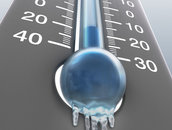With the artic front moving into the High Country on Monday and Tuesday, temperatures are expected to hit record lows. Here are some safety tips for the community to protect themselves against the cold temperatures:
Home safety:
o Check that all smoke and carbon monoxide detectors have batteries and are functional.
o Make sure space heaters are in good working order and have a 3-foot "circle of safety".
o Do not use unapproved means for heat. Do not use ovens, grills, or open fires indoors as additional means of heat.
o Wear layers and keeps hands & feet warm and dry. Wear plenty of layers, including hats, scarves, gloves, etc. If clothing becomes wet, remove it immediately and replace.
o Avoid overexertion. Cold weather puts an added strain on the heart. Unfamiliar exercise, such as shoveling snow or pushing a car, can bring on a heart attack or make other medical conditions worse. Take frequent rest breaks, and drink plenty of fluids to avoid dehydration.
o Check on friends, relatives and neighbors who may need assistance to ensure they are adequately protected from the cold Infants, seniors, and people with paralysis or neuropathy are at increased risk of hypothermia and frostbite.
o Keep cellphones charged and if possible, avoid traveling alone.
Car safety:
o If you must drive a vehicle, monitor weather and traffic reports for the latest road conditions.
o Keep an adequate supply of blankets, food, water, and flashlights in your car at all times.
o Drive only if it is absolutely necessary. If you must drive: travel in the day; don’t travel alone; keep others informed of your schedule; stay on main roads and avoid back road shortcuts.
o Let someone know your destination, your route, and when you expect to arrive. If your car gets stuck along the way, help can be sent along your predetermined route.
o If you experience trouble, stay with your car. Do not try to walk to safety unless help is visible within 100 yards.
o Display a trouble sign if you need help; tie a brightly colored cloth to the antenna and raise the hood to alert rescuers.
o Start the car and use the heater for about 10 minutes every hour. Keep the exhaust pipe clear of snow to avoid the risk of carbon monoxide poisoning.
o Consider making an Emergency Supply Kit!
Hypothermia is a life-threatening condition where body temperature is abnormally low. Symptoms may include shivering, slurred speech, sluggishness, drowsiness, unusual behavior, confusion, dizziness, and shallow breathing.
Frostbite is a serious injury to a body part frozen from exposure to the cold. It most often affects extremities like fingers and toes or exposed areas such as ears or parts of the face. Redness and pain may be the first warning of frostbite. Other symptoms include numbness or skin that appears pale, firm, or waxy.
If you are experiencing an emergency, immediately call 911.
Home safety:
o Check that all smoke and carbon monoxide detectors have batteries and are functional.
o Make sure space heaters are in good working order and have a 3-foot "circle of safety".
o Do not use unapproved means for heat. Do not use ovens, grills, or open fires indoors as additional means of heat.
o Wear layers and keeps hands & feet warm and dry. Wear plenty of layers, including hats, scarves, gloves, etc. If clothing becomes wet, remove it immediately and replace.
o Avoid overexertion. Cold weather puts an added strain on the heart. Unfamiliar exercise, such as shoveling snow or pushing a car, can bring on a heart attack or make other medical conditions worse. Take frequent rest breaks, and drink plenty of fluids to avoid dehydration.
o Check on friends, relatives and neighbors who may need assistance to ensure they are adequately protected from the cold Infants, seniors, and people with paralysis or neuropathy are at increased risk of hypothermia and frostbite.
o Keep cellphones charged and if possible, avoid traveling alone.
Car safety:
o If you must drive a vehicle, monitor weather and traffic reports for the latest road conditions.
o Keep an adequate supply of blankets, food, water, and flashlights in your car at all times.
o Drive only if it is absolutely necessary. If you must drive: travel in the day; don’t travel alone; keep others informed of your schedule; stay on main roads and avoid back road shortcuts.
o Let someone know your destination, your route, and when you expect to arrive. If your car gets stuck along the way, help can be sent along your predetermined route.
o If you experience trouble, stay with your car. Do not try to walk to safety unless help is visible within 100 yards.
o Display a trouble sign if you need help; tie a brightly colored cloth to the antenna and raise the hood to alert rescuers.
o Start the car and use the heater for about 10 minutes every hour. Keep the exhaust pipe clear of snow to avoid the risk of carbon monoxide poisoning.
o Consider making an Emergency Supply Kit!
Hypothermia is a life-threatening condition where body temperature is abnormally low. Symptoms may include shivering, slurred speech, sluggishness, drowsiness, unusual behavior, confusion, dizziness, and shallow breathing.
Frostbite is a serious injury to a body part frozen from exposure to the cold. It most often affects extremities like fingers and toes or exposed areas such as ears or parts of the face. Redness and pain may be the first warning of frostbite. Other symptoms include numbness or skin that appears pale, firm, or waxy.
If you are experiencing an emergency, immediately call 911.

